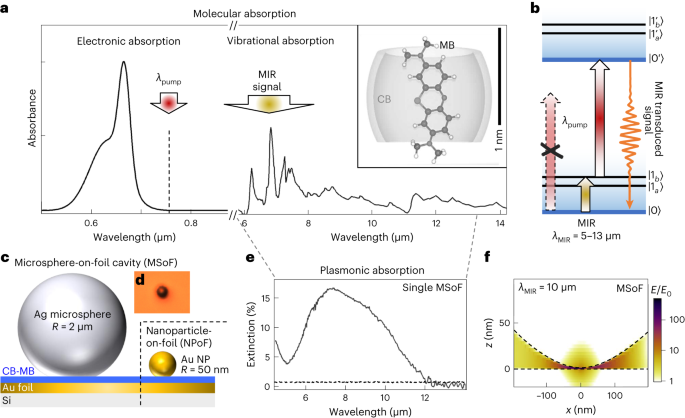2023-08-24 バーミンガム大学
◆この技術は、分子や化学反応の理解を深め、リアルタイムのガス検知、医療診断、天文学的調査、量子通信など、さまざまな用途に役立つ可能性があります。この革新的な方法は、赤外線活性分子振動に新たな洞察を提供し、科学研究だけでなく、実用的なデバイスの開発にも道を開く可能性があります。
<関連情報>
- https://www.birmingham.ac.uk/news/2023/making-the-invisible-visible-new-method-makes-mid-infrared-light-detectable-at-room-temperature
- https://www.nature.com/articles/s41566-023-01263-4
振動アシストルミネッセンスによる単一分子中赤外分光と検出 Single-molecule mid-infrared spectroscopy and detection through vibrationally assisted luminescence
Rohit Chikkaraddy,Rakesh Arul,Lukas A. Jakob & Jeremy J. Baumberg
Nature Photonics Published:28 August 2023
DOI:https://doi.org/10.1038/s41566-023-01263-4

Abstract
Room-temperature detection of molecular vibrations in the mid-infrared (MIR, λ = 3–30 µm) has numerous applications, including real-time gas sensing, medical imaging and quantum communication. However, existing technologies rely on cooled semiconductor detectors because of thermal noise limitations. One way to overcome this challenge is to upconvert the low-energy MIR photons into high-energy visible wavelengths (λ = 500–800 nm) where detection of single photons is easily achieved using silicon technologies. This process suffers from weak cross-sections and the MIR-to-visible wavelength mismatch, limiting its efficiency. Here we exploit molecular emitters possessing both MIR and visible transitions from molecular vibrations and electronic states, coupled through Franck–Condon factors. By assembling molecules into a plasmonic nanocavity resonant at both MIR and visible wavelengths, and optically pumping them below the electronic absorption band, we show transduction of MIR light. The upconverted signal is observed as enhanced visible luminescence. Combining Purcell-enhanced visible luminescence with enhanced rates of vibrational pumping gives transduction efficiencies of >10%. MIR frequency-dependent upconversion gives the vibrational signatures of molecules assembled in the nanocavity. Transient picocavity formation further confines MIR light down to the single-molecule level. This allows us to demonstrate single-molecule MIR detection and spectroscopy that is inaccessible to any previous detector.



